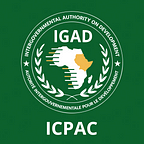One of the most pressing issues confronting humanity in the twenty-first century is how to deal with global climate change now and in the future. Climatic impacts like droughts, storms, and floods, have resulted in major natural disasters that, at their worst, cause death, loss of livelihood, epidemics, famine and displacement of people, as well as loss of personal and state-owned properties. For instance, Droughts negatively impact agriculture, the economy and the environment. The 2008–2010 drought for example, affected more than 13 million people in Eastern Africa; while the drought in 2010–2011 was the most extreme event seen in the region in 60 years at the time, leading to a severe food crisis and a famine affecting approximately 12 million people in Eastern Africa and particularly in Somalia(1). With global warming, extreme events such as drought have occurred more frequently and have become more severe in the past two decades(2). For example, Drought frequency in Eastern Africa has doubled from once every six years to once every three years since 2005(3).
According to the Intergovernmental Panel on Climate Change (IPCC) Sixth Assessment Report, Global warming is likely to reach 1.5°C between 2030 and 2052 if it continues to increase at the current rate. Given the intensity and frequency of extremes observed at 0.5°C increase, the impact of 1.5°C of warming will be adverse for the region who are already struggling to adapt.
This increased frequency of extreme climate events has made the need to predict them more urgent, to be able to manage and plan the resources before the events ravage. For mankind to manage the future climate, a consistent, reliable, properly quality-controlled accurate and easily accessible long record of the past and present climate should be provided, so as to construct climate models and create quality statistical prediction schemes. Unfortunately, availability of observed climate data remains the greatest challenge for Africa generally, with climate data where available being either inconsistent, have short records, missing values, unreliable or largely exist in hardcopy manuscript form making it not easily accessible and this makes it more difficult for the users to utilize the climate data.
In order to overcome these climate data challenges, many gridded precipitation products with variation in time and space have been produced and are freely available on a global scale (4). They are broadly classified into four categories. The first category is;
1. Gauge-only products are based solely on observations from rain gauge stations, are interpolated using various methods, and are frequently available at a coarser spatial resolution more than 0.5◦. They have been widely used in a variety of applications, including the Global Precipitation Climatology Centre (GPCC) monthly precipitation product (5).
2. Atmospheric models combine satellite and in-situ observations of various atmospheric properties as inputs. It includes among others, National Centers for Environmental Prediction-National Centre for Atmospheric Research (NCEP–NCAR)(6).
3. Satellite-only products use either the infrared (IR) information frequently measured from geostationary satellites, the microwave (MV) information less commonly measured from low earth-orbiting satellites, or a combination of IR and MV information(4).
4. Satellite-gauge products combine two individual (gauge-only and satellite-only) products through Different bias correction or blending procedures. They include, among others, Precipitation Estimation from Remotely Sensed Information using Artificial Neural Networks (PERSIANN), CPC MORPhing technique (CMORPH) available at a 0.25◦, or finer, spatial resolution and the recently released “satellite-gauge” type The Climate Hazards Group InfraRed Precipitation with Station data (CHIRPS product) which provides precipitation at the finest spatial resolution of 0.05◦(7).
The accuracy of these precipitation products has been assessed at various spatial levels, including global, continental, regional and country. Based on these previous evaluations;
It is clear that the available products have a global orientation and their performance varies by region and product. As a result, the only remaining task is to evaluate the appropriateness of these products to ascertain the best product at the required region before use.
The region needs to understand the benefits and challenges of the available products so as to help fill the data gaps in the region. These products could help give a better understanding of the historical climate of Eastern Africa. It is however important to note that so far, none of the products accurately mimic the observed data, and that further research is needed to understand which data works most effectively in each country.
References
- Amir AghaKouchak. A multivariate approach for persistence-based drought prediction: Ap- plication to the 2010–2011 East Africa drought. Journal of Hydrology, 526:127–135, 2015.
- Aiguo Dai. Characteristics and trends in various forms of the Palmer Drought Severity Index during 1900–2008. Journal of Geophysical Research: Atmospheres, 116(D12), 2011.
- Chris Funk, Pete Peterson, Martin Landsfeld, Diego Pedreros, James Verdin, Shraddhanand Shukla, Gregory Husak, James Rowland, Laura Harrison, Andrew Hoell, et al. The climate hazards infrared precipitation with stations — a new environmental record for monitoring ex- tremes. Scientific data, 2(1):1–21, 2015.
- Essayas K Ayana, Pietro Ceccato, Jonathan RB Fisher, and Ruth DeFries. Examining the rela- tionship between environmental factors and conflict in pastoralist areas of East Africa. Science of The Total Environment, 557:601–611, 2016.
- Eugenia Kalnay, Masao Kanamitsu, Robert Kistler, William Collins, Dennis Deaven, Lev Gandin, Mark Iredell, Suranjana Saha, Glenn White, John Woollen, et al. The ncep/ncar 40- year reanalysis project. Bulletin of the American meteorological Society, 77(3):437–472, 1996.
- Udo Schneider, Andreas Becker, Peter Finger, Anja Meyer-Christoffer, Markus Ziese, and Bruno Rudolf. Gpcc’s new land surface precipitation climatology based on quality-controlled in situ data and its role in quantifying the global water cycle. Theoretical and Applied Climatol- ogy, 115(1):15–40, 2014.
- Zheng Duan, Junzhi Liu, Ye Tuo, Gabriele Chiogna, and Markus Disse. Evaluation of eight high spatial resolution gridded precipitation products in adige basin (italy) at multiple tem- poral and spatial scales. Science of the Total Environment, 573:1536–1553, 2016.
